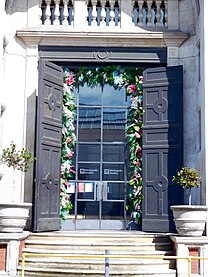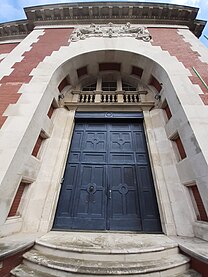Power House, Chiswick

The Power House, Chiswick is a former electricity generating station on Chiswick High Road and a Grade II listed building, completed in 1901. It provided power for the London United Electrical Tramway Company until 1917. The upper part of the building was converted for residential use in 1985, and the lower part for use as a recording studio in 1989.
Architecture
[edit]The Power House was built as an electricity generating station for the London United Electrical Tramway Company between 1899 and 1901.[1]
The Power House was designed by the architects William Curtis Green and J. Clifton Robinson;[2][3] the building engineer was a Mr. Parshall.[1] It is described in Bridget Cherry and Nikolaus Pevsner's The Buildings of England as a "monumental free Baroque brick and stone composition".[1] The building is rectangular, with five bays on one pair of faces, and three bays on the other pair. There is a large cornice with brackets above enormous arches which have long voussoirs in stone.[1] The façade above the front entrance is adorned with two large carved female figures that represent 'Electricity' and 'Locomotion'.[1][2] As built, it had a 260-foot high steel smoke-stack.[4]
Cherry and Pevsner call the Power House "by far the most exciting building"[1] of Chiswick High Road and Turnham Green, and "the best surviving example in London from the early, heroic era of generating stations whose bulky intrusion in residential areas was tempered by thoughtful architectural treatment".[1]
Usage
[edit]The building had a short working life as a generating station; in 1917 power generation was taken over by the generating station at Lots Road, Chelsea.[2] The Power House however continued to be used as a substation until 1962, when the trolley bus service was closed. In 1966 the building's chimney was demolished.[2] London Transport decided to redevelop the site. This led to an outcry, and the Victorian Society campaigned for the protection of the building from the developers. This resulted in a Grade II listing for the building in 1975;[5] it was one of the first Victorian buildings to be so nominated, and the first for one built in the 20th century.[6]
In 1985, the upper part of the building was converted into residential accommodation, including a penthouse which is split over three levels,[6] and flats "ingeniously tucked into the roof".[1] The architects were David Clarke Associates.[1]
In 1989, the four lower floors of the building were converted by Powell-Tuck Connor & Orefelt into recording studios, including "an elaborate original iron staircase."[1][3] The studios are used by Metropolis Group.[7] Artists whose music has been variously recorded, mixed or mastered in the building include Adele, Amy Winehouse, George Michael, Jay-Z, Justin Bieber, Lady Gaga, Mark Ronson, Prince, Queen, Rihanna, and The Rolling Stones.[8]
-
West side
-
'Electricity' and 'Locomotion' above south doorway
-
Northwest corner cornice detail
-
North entrance
-
North doorway
-
South doorway
-
Southwest corner detail
-
Babcock & Wilcox boilers inside, 1902
References
[edit]- ^ a b c d e f g h i j Cherry, Bridget; Pevsner, Nikolaus (1991). The Buildings of England. London 3: North West. London: Penguin Books. p. 405. ISBN 978-0-14-071048-9. OCLC 24722942.
- ^ a b c d Clegg, Gillian. "Chiswick History: Travel". Brentford and Chiswick Local History Society. Retrieved 27 July 2021.
- ^ a b Green, Oliver (2016). Rails in the Road: A History of Tramways in Britain and Ireland. Pen and Sword. p. 111. ISBN 978-1-4738-6941-7.
- ^ "Chiswick: Economic history". British History Online. Retrieved 27 July 2021.
- ^ "Former Tramways Sub-Station at Rear of Number 72 Chiswick High Road". britishlistedbuildings.co.uk. Retrieved 17 March 2018.
- ^ a b "The Power House Chiswick High Road, Chiswick, London, W4 1SY". savills.com. Retrieved 16 March 2018.
- ^ "Metropolis Studios". Metropolis Group. Retrieved 27 July 2021.
- ^ "Portfolio". Helical. Retrieved 27 July 2021.









